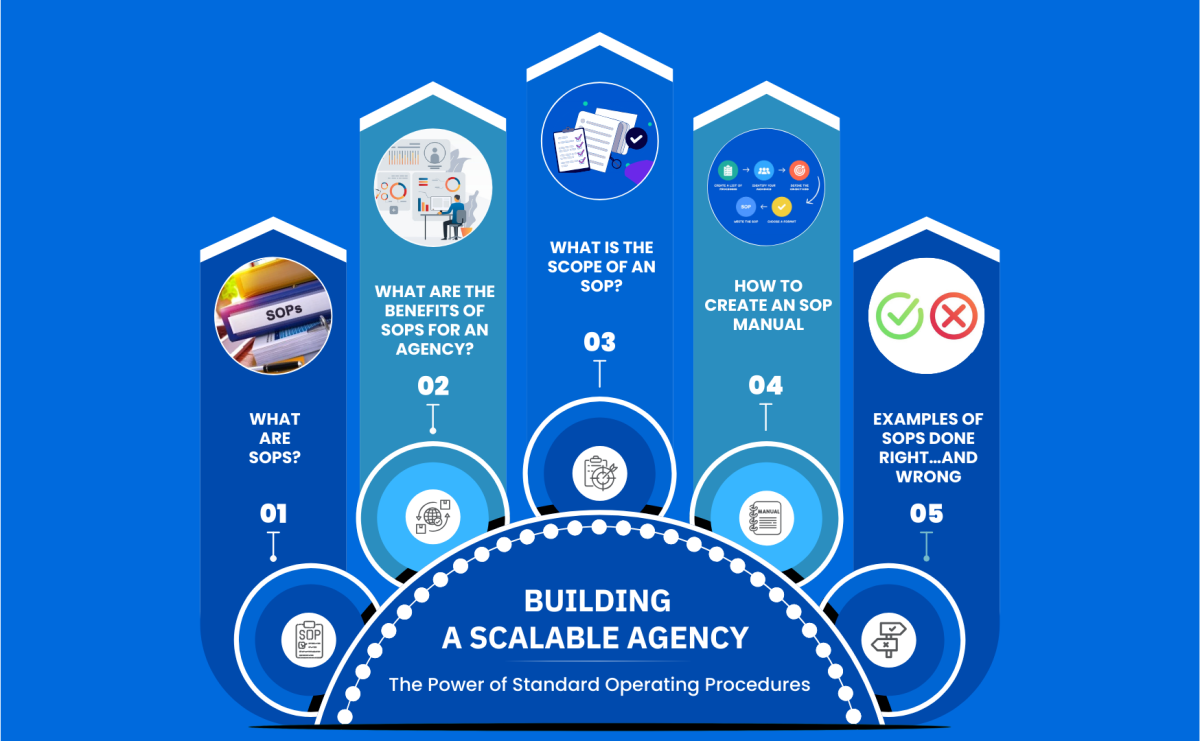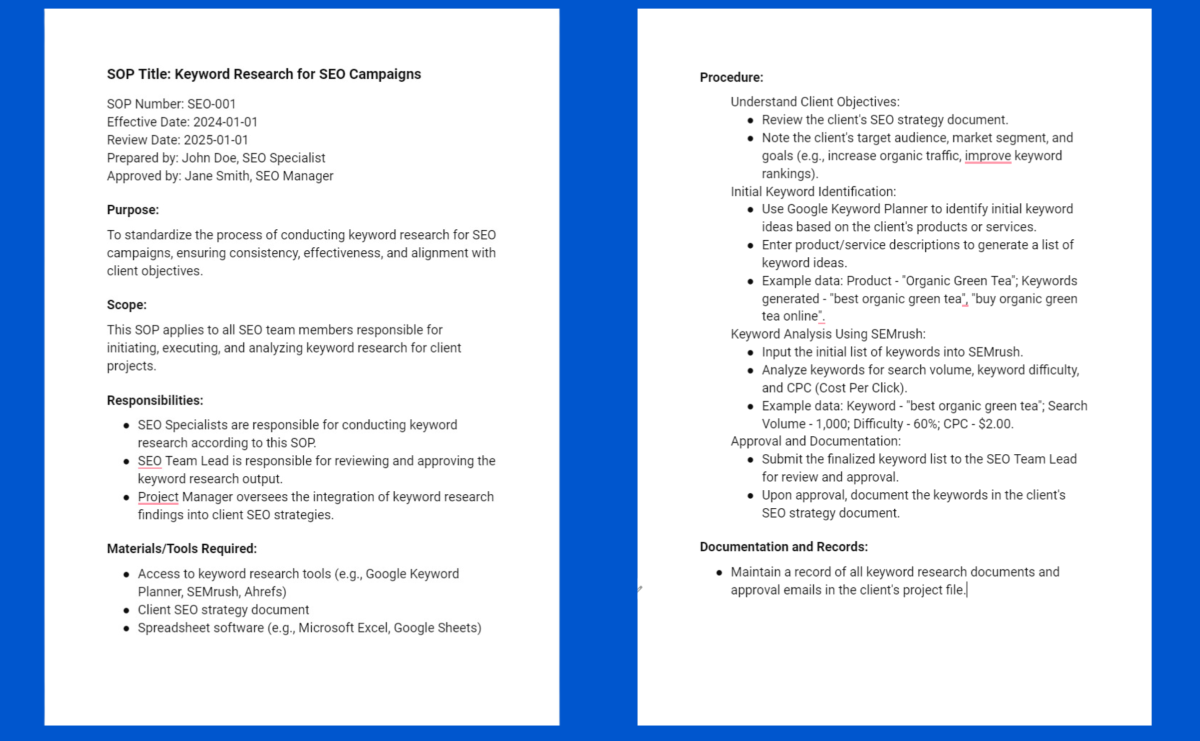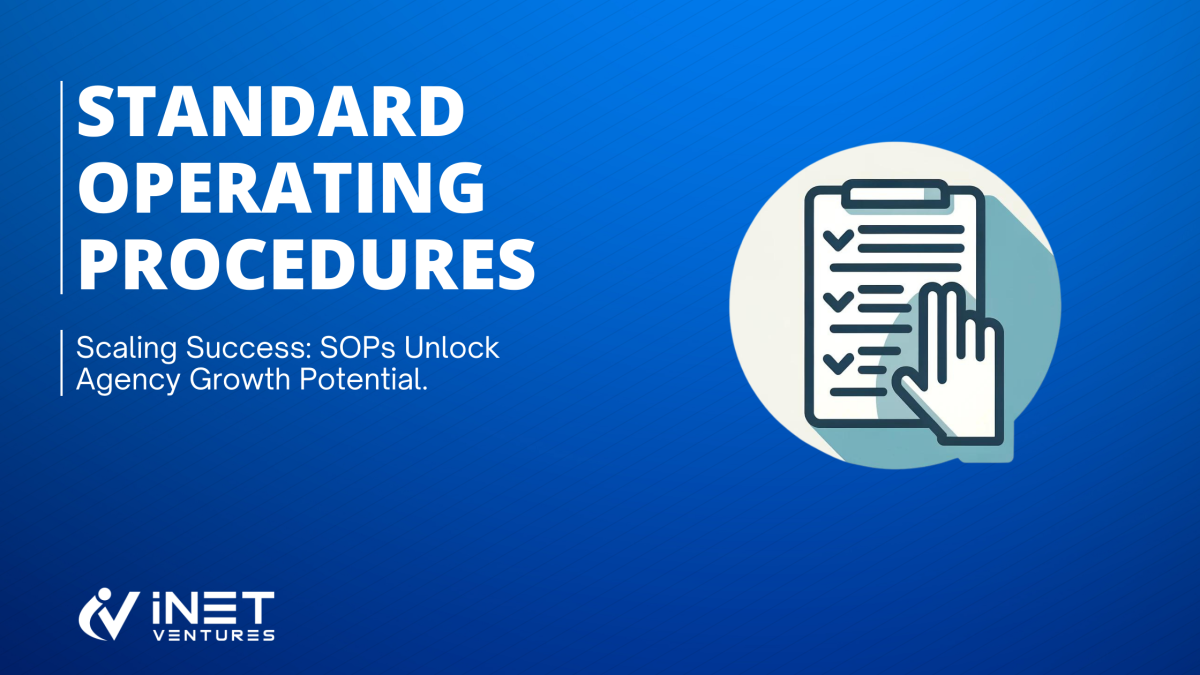If you’re heading up an agency, there’s a good chance you’ve heard of SOPs, or standard operating procedures.
Agencies can be chaotic businesses, with many different projects requiring tailored approaches. Nevertheless, it’s important to put standardisation processes in place, especially if you’re looking to scale.
That’s where standard operating procedures come in. Armed with SOPs, your agency will be equipped to scale, and you won’t have to worry about addressing the particulars of each and every project and assignment that comes your way.
We’re here to talk about what SOPs are, how you can implement them successfully, and what kind of challenges you might face when doing so.
Here’s our guide to all things SOP!

What are SOPs?
So, let’s get the obvious question out of the way first: what exactly is an SOP?
You can think of SOPs as detailed how-to guides that instruct your agency on how to complete a certain task or set of tasks. If a procedural document is an overview of your agency’s workflow, an SOP gets into the weeds, so to speak.
A good SOP lays out exactly what to do at every stage of a project; it contains detailed instructions regarding how to complete that project and leaves pretty much no room for doubt or interpretation.
In many other lines of work, an SOP can even help to reinforce safety guidelines and measures; with a standard operating procedure in place, employees are far less likely to make critical mistakes, potentially leading to workplace safety issues.
Of course, when it comes to agencies, these situations are less likely to happen, so SOPs are mainly aimed at increasing efficiency and consistency across the agency as a whole.
SOPs can differ from agency to agency as well. There’s no such thing as a one-size-fits-all SOP; each agency will have its own way of writing an SOP that caters to that agency’s particular needs.
Having said that, there are certainly best practices when it comes to writing SOPs, and we’ll go into that a little later on.
For now, just know that SOPs are in-depth documents that both outline your agency’s way of doing things and provide more specific guidelines for staff to execute projects to spec.
What is the importance of an SOP for an agency?
Now that we’ve discussed what exactly SOPs are, let’s talk about why they’re important for your agency.
First up, SOPs are crucial when it comes to scaling your agency. If you want to grow your business and attract more clients, then you’re going to need proof that your method works.
An SOP can be a great way to ensure that your agency achieves scalability because each new employee that comes your way will know exactly what they’re doing, which means that your agency’s work will be consistent no matter what your staff makeup might look like.
If a particular employee finds a more efficient way of approaching projects or tasks, then you can implement this into your agency’s SOPs, thus ensuring that employee’s knowledge will never be lost, no matter whether they remain with the company or not.
Agency SOPs are also important when it comes to increasing efficiency; if each employee knows what they’re doing at any given time, then there shouldn’t be any pause in the workflow, thus ensuring that projects are completed within deadline.
SOPs can also help your agency to achieve consistency. With little room for interpretation, an SOP can lay out exactly how an employee should approach a task, which means that results should be consistent across the agency as a whole.
There are a number of reasons that SOPs are important for any agency, and we’ve just listed a few of them here. Suffice it to say that there’s no real reason your agency shouldn’t be considering implementing SOPs.
What is the scope of an SOP?
This is a question that’s very difficult to answer in a holistic sense.
Each agency will differ in terms of its approach to SOPs, so the answer to the question “what is the scope of an SOP?” is, rather disappointingly, “it depends”.
Let’s say that you’re running a branding agency that helps clients to create unique branding for their business.
The scope of one particular SOP for your agency might, for instance, encompass the different elements of that branding; you might have an SOP that incorporates a step-by-step process by which you can create a holistic brand for the client.
That SOP might also include troubleshooting steps if the client isn’t happy with the branding you’ve created, as well as the creation of a number of alternative branding solutions that the client could examine instead.
As such, the scope of your SOP may expand to include customer relations, or it may simply relate to the branding process itself, and you may wish to leave the customer service element of the job to a separate department.
Of course, your SOP might also incorporate the customer service department itself; if you’re creating an agency-wide SOP, then it stands to reason that different areas of the business would be included.
The scope of any given SOP is largely up to you as the agency’s head, so again, there’s no “right answer” here; if you realise that any area of your agency requires an SOP, then it stands to reason that you should write one encompassing those elements of the business.
How to create an SOP manual
So, we’ve talked about what SOPs are, why they might be important for your agency, and what their scope should be. Now, it’s time to think about how you can create one.
In any problem-solving process, the first step is identifying the problem itself. It’s the same with an SOP; you should take a look at your agency’s processes and see where there might be room for increasing efficiency.
Again, it’s hard to create granular examples of this process, because it’s going to look different from agency to agency. Generally speaking, though, a good rule of thumb when it comes to “zooming out” is to look at areas where your agency needs improvement and start there.
Once you’ve identified the area where your SOP needs to be written, it’s important to bring in your business’ best and brightest minds to help you pinpoint a procedure that will form the backbone of your SOP.
Here’s a basic example below of an SOP

Creating SOPs should be a collaborative process, and you also want to ensure that any mistakes you might make are covered by other pairs of eyes that can help you identify and rectify those mistakes.
Clearly define each stage of the process for which you’re writing the SOP. Try to think logically and in a linear fashion; how might someone typically achieve the task you’re aiming to standardise?
Write each of these steps down, making sure to slot in any that you might initially forget. Be sure to also include any extra resources that employees may need in order to complete their task according to the SOP.
It’s a good idea to embark on a trial run of your SOP to see if it works, too; the only way to learn is by doing, after all, and if there are any areas of your SOP that need work, you’ll only know what they are if you try it out yourself.
Examples of SOPs done right…and wrong
As you might expect, tons of businesses have implemented standard operating procedures, and there are lots of examples out there to help you understand how to write your own.
We’re big fans of the SOP examples included over on Indeed, which include concise, specific SOPs related to copywriting, hiring procedures, and more.
You can also take a look at the list of SOP examples featured on Whatfix (don’t worry, they’re free, and the site even encourages you to “steal” them), which, again, demonstrate how to write concise and clear SOPs.
Naturally, there are fewer examples of bad SOPs; these documents don’t tend to make it outside of their companies of origin, largely because they don’t tend to last long before being replaced or scrapped entirely.
However, there are a few rules of thumb when it comes to avoiding writing bad SOPs. Here are some of the pitfalls into which bad SOP writing can often fall.
- Too long or too verbose. A good SOP is brief, to-the-point, and informative. If your SOP is too wordy or lengthy, then you run the risk of staff members ignoring it because they don’t have the time or inclination to read it.
- Too scattershot. It should be obvious to all staff members where the resources for your SOP are located. If it’s not, or if those resources are in disparate places, this may cause efficiency to drop.
- Too old. If you haven’t updated your SOP in a while, then it may not apply to your agency’s current workflow, effectively making it a completely pointless document. Be sure to update your SOPs regularly if you want to stay competitive.
As the founder of iNet Ventures, James deeply understands the world of SEO, link building, growth, and strategy. After achieving remarkable results for agencies and websites, his approach combines industry knowledge with forward-thinking tactics, which embark on analytical tools and AI.


